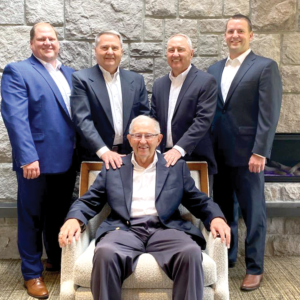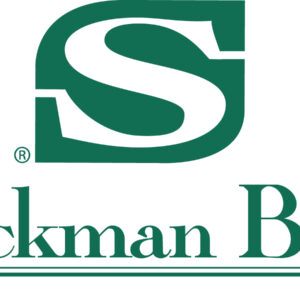By Evelyn Pyburn
One of Billings’ biggest and more thriving businesses is celebrating their 100th birthday. A & I Distributing may not be a readily recognized name for those not involved in the automotive business, but be assured if you own any kind of a vehicle you most likely have used a product they have distributed, as have many others throughout the eight state region they serve from their headquarters at 900 1st Ave North in Billings.
A & I Distributing is a fifth generation, family-owned and operated business. It was essentially started in 1924 with the involvement of Don Stanaway’s father, Frank, and today two of Don’s sons and two grandsons manage the business – with great grandkids in the wings. They are joined by some 242 employees, many of whom have been with the company for a significant number of those 100 years.
A couple hundred employees and customers attended a 100 year celebration last Tuesday, and numerous other celebrations will be held in other communities throughout their service region this summer.
1924 was the era in which the automobile market was beginning to get sound footing. People were beginning to realize that the automobile was here to stay, and indeed was changing the world forever.
Cars were quickly becoming a major source of freedom, adventure, and leisure, significantly improving the standard of living and altering urban development. But even at that, as a company brochure reminds, it was a time when there were “few cars, and less roads” and it took three to four days to travel 90 miles, “depending on how many flat tires you had.”
Transportation was in full swing of transitioning from the horse and buggy era. Manufacturers had found ways to make cars more efficient, and safer to drive. Roads were being designed and constructed for automobiles. Tunnels were being built and entrepreneurs were building gas service stations everywhere, to serve a rapidly growing need.
The company saw its nebulous beginnings when P. E. Crawley, realizing that the industry needed more than gasoline, started a distributorship of other automotive supplies. Crawley, an English boxer from London, started Crawley Motor Supply in Butte.” The small company sold tires, tire “boots,” and tube patches. In 1926 they expanded their line to include motor oil and greases. It gained the Pennzoil distributorship.
Today, A & I dominates the passenger car motor oil distribution business in the United States.
The secret to the company’s success? One thing, explained Stanaway is “you have to keep up with the times.” That means hiring young people with new ideas and retaining older people “with a blend of caution and ‘show me.’”
There are two parts to the business: passenger car motor oil, and commercial and industrial. A & I Distributors is the bulk packager of the four leading brands – Pennzoil, Castrol, Quaker State and Valvoline. It also has its own private label, “Service Pro PCMO” and “Purus C & I,” along with other brands such as Motorcraft, Shell, Citgo and Lucas.
Frank Stanaway’s younger brother, H. R. (Bud) Stanaway, started working at Crawley Motor Supply in 1927 as a tire mounter, shipping and receiving clerk, and in sales. Despite the Great Depression and severe drought in the 1930s, the company grew, with Bud and others working seven days a week, 12-14 hours a day.
Frank joined the company and in 1937 and moved to Billings to open the Billings branch. A branch was also opened in Great Falls, managed by Ken Lord. That was the same year that seven-year-old Stan started traveling the roads of Montana with his Dad making sales calls, while his mother, Lillian, took orders and ran the Billings branch.
In 1941, the attack on Pearl Harbor happened and WWII began. Bud, Frank and Lillian Stanaway and Ken Lord worked day and night to keep the company going through those troubled years.
Don Stanaway returned home from the Korean War and joined A & I. Frank Stanaway died in 1956 and his widow, Lillian, and Don took over the leadership roles in Billings.
In 1975, Crawley Motor Supply was dissolved and Automotive & Industrial Distributors became the principle owner of the corporation. By 1985, A & I Distributors of Billings had acquired the Butte and Great Falls operations.
From there, the company began expanding, opening branch office in Bismarck, Missoula, Spokane, Rapid City, Boise and Pocatello, Portland, and Arlington, Washington.
Don is especially proud of his family and their achievements, especially those prior to joining A & I. While both sons, very much like their father, grew up in the business, each son pursued full-fledged professional careers before retiring and returning to A & I. Scott Stanaway, now President of A & I, had a 30 year career as an attorney, and Skip Stanaway, now Chairman of A & I, was an architect.
Grandsons, Tucker and Tate finished college and then in 2006 they opened an A & I branch in Oregon, and invited their father to join them. They started it from scratch, says Don proudly, and are doing quite well.
And, just in case, one is tempted to think the company is resting on its laurels – Tucker and Tate started the Arlington, Washington branch in 2023. Again, from scratch. The branch opened without a single customer but the potential is exciting. Don points out that there are more people and cars in the area of Arlington than there are in “all the other states put together.”
A & I has a “huge number” of trucks. Don explained, “We deliver to every town, once a week”, from the Minnesota border to Arlington, Washington. Just in case your counting that is a stretch of 1,273 miles.
When asked what is the most significant change he has seen over the years, Don readily pointed to regulations. “It has increased dramatically.” As a case in point, Don explained that only a couple years ago one driver did all the paper work required by the Department of Transportation. “Today we have three full time people doing paper work for the same number of trucks.”
Another regulation comes from OSHA. Every morning every truck driver has to sign a statement saying they have crawled under their trucks and inspected for safety issues. That’s not so bad on a nice day, but what about when its ten below and there is two feet of snow on the ground, questions Don.
A requirement that a driver can only drive a certain number of hours is often very costly. For example, if a driver expends his allotted hours and is sitting in Sheridan, Wyoming – two hours from Billings — another driver must drive to Sheridan to pick him up. And while that may be burdensome enough for a company like A & I which is hauling cases or oil and other supplies, “What if you have a load of cattle?” asks Don
It is apparent in conversation with Don Stanaway that he keeps up on the most current regulations and political and economic issues that impact his business – and many other businesses for that matter.
One of the issues that long bothered Don was how to pass a family owned business on to the next generation without inheritance taxes destroying it. With four generations involved in the family business the issue of “death taxes” has long plagued Don.
He laughs and says that his wife, Dolly, who he met in seventh grade, claims he has been worried about dying since he was 21. Don adds that Dolly has been “a fabulous wife and mother” and “has a totally different personality from his.”
And while Don believes he has found ways to solve the problem somewhat for his family, and also for A & I employees, it remains quite difficult to pass on real estate – property paid for with after tax dollars – and he laments the situation faced by farmers and ranchers. It’s no wonder there are so few younger people remaining in agriculture, he said.
A & I Distributing provides employees with a stock option plan (called ESOP). Don explained that employees help build the business and deserve to share in its success.
Asked about how he and his family deal with the daily pressures of business, Don, who says he thinks about business 24/7 ,says he believes he and his family are blessed because they all play a musical instrument and were involved in athletics. He explained that in order to relieve the pressure of dealing with business issue, he plays the trombone. “I’m not a natural musician,” he said, so he has to focus all of his attention on playing the trombone, which he has played since he was a youngster and had the good fortune of meeting Tommy Dorsey who inspired him. He also played athletics.
His sons and grandsons also play musical instruments and were involved in athletics. So while their music helps relieve stress, playing athletics teaches you about team work, said Don. “In team sports you have to get along. Same way in business. We have the same team goal in business as in playing sports.”



